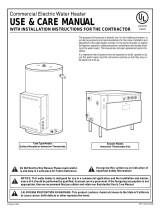6
WARNING
To minimize the possibility of serious personal injury or death, fire or damage to your appliance,
never violate the following safety rules:
1. Always keep the area around your appliance free of combustible material, gasoline and other
flammable liquids and vapors.
2. Never cover your appliance, lean anything against it, store trash or debris near it, stand on it or any
way block the access to your appliance.
CODES:
The equipment shall be installed in accordance with those installation regulations in force in the local area
where the installation is to be made.
These shall be carefully followed in all cases. Authorities having jurisdiction shall be consulted before
installations are made. In the absence of such requirements, the installation shall conform to the latest edition
of the National Electrical Code, NFPA 70. When the appliance is installed in Canada, it must conform to the
CAE C22.1, Canadian Electrical Code, Part 1 and/or local Electrical Codes.
APPROVALS:
This complete appliance is design certified and
Listed by Underwriters Laboratories as a
commercial
storage electric water heater. This
water heater bears the UL certification for the
United States as tested
under the Standard for
Electric Booster and Commercial Storage Tank
Water Heaters, UL1453 and C-UL
in Canada as
tested under the Standard for Construction and Test
of Electric Storage Tank Water Heaters,
CAN/CSA-C22.2 No. 110-M90. All water heater
storage tanks conform to the latest edition of the
ASME
Boiler and Pressure Vessel Code, Section Iv.
INSTALLATION PROCEDURE LOCATION OF UNIT
1. Locate the appliance so that if water
connections should leak, water damage
will not occur. When
such locations cannot be avoided, it is recommended that
a suitable drain pan, adequately sized,
be
installed under the unit. Under no
circumstances is the manufacturer to be
held responsible for
water damage in
connection with this unit, or any of its
components.
2. Insure that the appliance is located near
an acceptable drain so that the vessel can
be properly drained
when performing
service or maintenance. The drain must
also provide adequate drainage in the
event
of leakage the tank or related
piping. The drain must prevent water damage to the adjacent area
and lower
floors of the structure.
3. The appliance must be installed so that the electrical components are protected from water (dripping,
spraying, etc.) during appliance operation and service (replacing of fuses, elements, etc.)
4. Appliances located in a garage or parking structure shall be installed so that the jacket and all piping
shall be located or protected so that it is not subject to physical damage by a moving vehicle.
5. The appliance must be installed on a level floor. Shim the base as necessary if leveling is required.




















